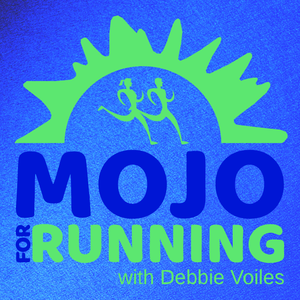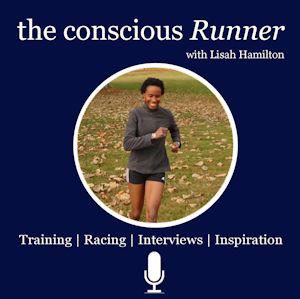
Mojo For Running Podcast
Debbie Voiles
- 7 minutes 30 secondsMFR 164: Hill Racing Strategy
With the right hill racing strategy and the finesse learned in the last episode, you'll be ready to crush any hill in any race, knowing that you have an edge over the other runners, knowing that your performance will be better because of your knowledge of hill strategy and your execution.
It's not hard, but it's something most runners give little attention. Most runners hope to manage any hills in a race, but that's a mistake. You must own hills, and you can.
Then, you'll be looking for races with hills because you'll know you have an advantage, and you'll be confident that you know exactly what to do.
9 September 2024, 9:43 am - 11 minutes 52 secondsMFR 163: Hill Training as Speedwork and Hill-Running Technique
For most people, running hills is an element of running to tolerate, but to the wise, properly trained and knowledgeable runner, hills provide an avenue to faster running and faster races. Between improved conditioning from using hill training as speedwork and improved hill-running technique, any runner's mindset should change from dreading hills to embracing hills.
26 August 2024, 1:41 pm - 8 minutes 33 secondsMFR 162: HIIT Training for Speedwork
High intensity interval training has been a recognized training modality for a dozen years, now, and over that time its effectiveness and versatility have proven it to be worthy of inclusion in the training regimen of any serious runner, but more than that, we now know that high intensity interval training has many health benefits, including benefits for heart health.
Resources mentioned in the episode:
Mayo Clinic Podcast, Nutrition & Fitness, The Role of High Intensity Interval Training and Stregnth Training in Cardiovascular Health.
NIH: High-intensity interval training for health benefits and care of cardiac diseases - The key to an efficient exercise protocol
13 August 2024, 5:40 pm - 8 minutes 52 secondsMFR 161: Progression Runs
Progression runs do wonders for speed, endurance, and fitness, preparing the runner to run faster farther into their race, hopefully, ideally throughout their race, but also offering a wide range of fitness benefits. Simply put, a progression run starts slower and gets continually faster; however, as with all forms of speed work for running, the many variations make it possible to tweak the workout, optimizing it for the desired race goal or training goal, keeping it interesting while still challenging. Progression runs are an excellent means of improving running fitness.
15 July 2024, 3:08 pm - 13 minutes 41 secondsMFR: 160: Tempo RunsThe traditional tempo run is entirely different from the typical track type of speedwork, a workout that consists of continuous running at a given pace. Tempo runs are longer and less intense becauase of the longer distance, but they have their own valuable benefits that provide critical conditioning as well as mental training needed for longer race distances. In this episode, you'll learn how to do a tempo workout, and how to schedule it into the scope of your speedwork within your training cycle. Plus, Deb provides several examples of variations of tempo training. ImageLift1 June 2024, 5:00 pm
- 18 minutes 12 secondsMFR 159: Six Activities to Add to Track Workouts to Make Them More Fun and More Effective
While a good track workout is always effective, adding other activities between sets will magnify the impact and make speed workouts more fun. As a result, you're likely to be more consistent with speed training and benefit more from it.
In this episode, you'll discover how to gradually incorporate balance, plyometric, and agility exercises into the training, which will result in improved running form, more efficient running, fewer injuries, and faster times.
The exercise options include but are not limited to jumping rope, jumping jacks, hulahooping, one-leg balance work, and a series of drills that combine several of these.
Now, listen and prepare to take your speed training to the next level.
Mojo for Running Coaching
18 May 2024, 8:00 am - 15 minutes 35 secondsMFR 158: Repeats and Intervals
Learn all about classic track workouts and the variety of ways they can be structured to meet any runner's training goals.
All speedwork can be broken down into two categories, short speedwork, usually done on a track, a combination of repeats, intervals, and sets, and longer speedwork done on roads
In this episode, discover the near infinite ways to structure workouts of repeats and intervals to accomplish a variety of goals.
26 April 2024, 5:37 pm - 15 minutes 54 secondsMFR 157: Speedwork, how and when to incorporate speedwork into your running training
To get faster or stronger or even to build endurance, every experienced runner needs speedwork. This is the first of a series of episodes on speedwork for runners, what is a speedworkout, who should do it, how to add it to your running schedule, how often, types of speed training, how to maximize benefits, and what not to do.
10 April 2024, 7:00 am - 21 minutes 35 secondsMFR 156: The Challenge of Holiday Running and the Mojo for Running December Challenge
The month of December tests our running training more than any other as holiday events too often steal running hours. Our already hectic schedules get still busier, increasing stress levels, meaning we need run therapy more than ever, but ironically, that's the last thing on many people's mind. The Mojo for Running December Challenge will provide accountability and motivation to help you maintain running fitness during this month, setting you for success in 2022.
3 December 2021, 2:48 am - 17 minutes 49 secondsMFR 155: Head to Toe, a Close Look at How to Move and Where to Look When You Run
Let's go back to the basics of how to move when you run, head to toe, from where to look, to the nuances of effective arm technique, what not to do and physical cues to help with practicing good running form.
While everyone's form will be unique, based on their body, minor adjustments will still pay off with greater comfort, improved endurance, greater speed, and fewer running injuries, all good reasons to focus on running form during every mile of every run. The goal is to practice the running form that's easiest on the body, the most efficient form, a movement that is light and fluid. Since practice makes permanent, it's not enough to do form drills and then let it go or to practice form, occasionally. Every runner needs to think about form and make practicing the elements of good running form a daily ritual.
Two prior episodes referred to:
MFR 77: How to Run Hills, Part 1, Uphill MFR 78: How to Run Hills, Part 2, Downhill
This episode includes a reminder for listeners to enter the Gasparilla Distance Classic's Name the Parrot contest. Enter here.
Register for Deb's race, the gnome-themed Run Tampa Tinsel Run, December 11th, here. Check out the medal and shirt art.
21 October 2021, 8:19 pm - 15 minutes 4 secondsMFR 154: Fun With Fartlek Training
Any runner or group of runners, of any level, can make up a fartlek workout on the fly, or pull out one of the traditional, time-tested fartlek workouts. Fartleks are especially good for injecting a bit of speed work into an easy or long-ish run during the basebuilding phase when it's best to avoid more structured, specific track workouts, saving them for later in the cycle when the speedwork needs to be more specific, more race oriented.
This matters because from a psychological perspective, runners will benefit from more carefree, less structured running, fun running, but they still don't want to lose their edge by foregoing all speed work. Enter, fartleks, the perfect means of holding onto speed without going to a track.
RunGasparilla.com/name-the-parrot-contest
Gear/equipment mentioned:
Gymboss (wearable interval timer)
Simple Interval Timer (iphone app)
9 October 2021, 2:37 am - More Episodes? Get the App
Your feedback is valuable to us. Should you encounter any bugs, glitches, lack of functionality or other problems, please email us on [email protected] or join Moon.FM Telegram Group where you can talk directly to the dev team who are happy to answer any queries.
 Run to the Top Extra Kick Podcast | Answers to Your Running Questions
Run to the Top Extra Kick Podcast | Answers to Your Running Questions
 The Running Podcast
The Running Podcast
 The Conscious Runner Podcast
The Conscious Runner Podcast
 RunBuzz Running Podcast
RunBuzz Running Podcast
 Diz Runs Radio: Running, Life, & Everything In Between
Diz Runs Radio: Running, Life, & Everything In Between
 The Running Lifestyle Show
The Running Lifestyle Show